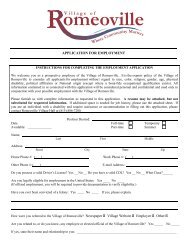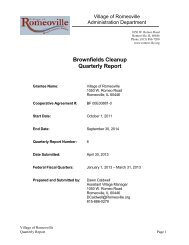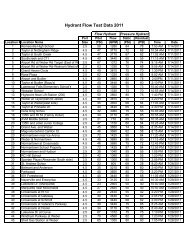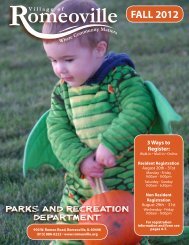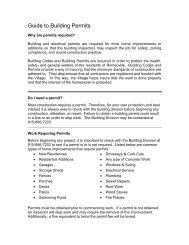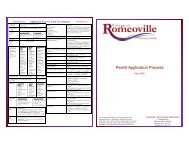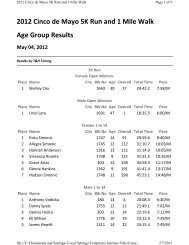- Page 1 and 2:
ILLINOIS SITE REMEDIATION PROGRAM C
- Page 3 and 4:
TABLE OF CONTENTS EXECUTIVE SUMMARY
- Page 5 and 6:
APPENDICES Appendix A Historical Do
- Page 7 and 8:
The far northeast Former Clark Stat
- Page 9 and 10:
‣ Tier 2 soil component of the Cl
- Page 11 and 12:
Section 4 - Documentation of Field
- Page 13 and 14:
Physical Setting Sources: • Berg,
- Page 15 and 16:
The Will Silty Clay Loam is a poorl
- Page 17 and 18:
Groundwater Classification: The sat
- Page 19 and 20:
y Dalhart Avenue to the west, Norma
- Page 21 and 22:
The soil gas samples were submitted
- Page 23 and 24:
3.3 INVESTIGATION MONITORING AND EQ
- Page 25 and 26:
casing volumes and allowed to recha
- Page 27 and 28:
Summary results of analyses are pre
- Page 29 and 30:
4.3 REC 1 - FORMER DRY CLEANING OPE
- Page 31 and 32:
5.0 ENDANGERMENT ASSESSMENT The Sit
- Page 33 and 34:
5.3 SITE RECOGNIZED ENVIRONMENTAL C
- Page 35 and 36:
• There is no evidence of hazardo
- Page 37 and 38:
As summarized in (Tables 1.1, 2.1 t
- Page 39 and 40:
‣ The Village of Romeoville maint
- Page 41 and 42:
A Tier 1 RO evaluation of Site data
- Page 43 and 44:
FIIGURES
- Page 45 and 46:
± Various Retail & Commercial Busi
- Page 47 and 48:
FIGgwcontour07292.dgn 5/14/2010 12:
- Page 49 and 50:
FIGRECs07292.dgn 5/16/2010 1:07:17
- Page 51 and 52:
FIGbor_exceed07292.dgn 5/19/2010 4:
- Page 53 and 54:
TABLES
- Page 55 and 56:
Table 1.1 Summary of Soil and Groun
- Page 57 and 58:
TABLE 2.1 - SOIL ANALYTICAL RESULTS
- Page 59 and 60:
TABLE 2.2 - SOIL ANALYTICAL RESULTS
- Page 61 and 62:
TABLE 2.4 - SOIL ANALYTICAL RESULTS
- Page 63 and 64:
Volatile Organic Compounds (Method
- Page 65 and 66:
TABLE 3.2 - GROUNDWATER ANALYTICAL
- Page 67 and 68:
Chemical Name and Soil Remediation
- Page 144 and 145:
February 13, 2008 Ms. Dawn Caldwell
- Page 146 and 147:
SIGNATURES OF ENVIRONMENTAL PROFESS
- Page 148 and 149:
LIST OF APPENDICES Appendix I Quali
- Page 150 and 151:
material risk of harm to public hea
- Page 152 and 153:
terms with Village of Romeoville. T
- Page 154 and 155:
The following published documents w
- Page 156 and 157:
An ALTA/ACSM Land Title Survey was
- Page 158 and 159:
Hydrogeology: Based on regional top
- Page 160 and 161:
The EDR database report identified
- Page 162 and 163:
One site was identified as part of
- Page 164 and 165:
Multiple historical sources were re
- Page 166 and 167:
Independence Boulevard followed by
- Page 168 and 169:
All tenants Mexican Restaurant Laun
- Page 170 and 171:
Parking lot, northeast of building
- Page 172 and 173:
8.0 FINDINGS, OPINIONS & CONCLUSION
- Page 174 and 175:
± Approximate Site Boundary V3 Com
- Page 176 and 177:
± Spartans' Square Shopping Center
- Page 178 and 179:
Ms. Dawn Caldwell Village of Romeov
- Page 180 and 181:
Ms. Dawn Caldwell Village of Romeov
- Page 182 and 183:
FIIGURES
- Page 184 and 185:
± Approximate Site Boundary Variou
- Page 186 and 187:
TABLES
- Page 188 and 189:
TABLE 2 - GROUNDWATER ANALYTICAL RE
- Page 190 and 191: 10173 V3 Boring Log Report Boring N
- Page 192 and 193: 10193 V3 Boring Log Report Boring N
- Page 194 and 195: 10209 V3 Boring Log Report Boring N
- Page 196 and 197: 10225 V3 Boring Log Report Boring N
- Page 198 and 199: 10247 V3 Boring Log Report Boring N
- Page 200 and 201: CHAIN-OF-CUSTODY PROTOCOL Laborator
- Page 202 and 203: DECONTAMINATION ACTIVITIES PROTOCOL
- Page 204 and 205: • Depth at which saturated condit
- Page 236 and 237: BEACON Report No. 2096 PASSIVE SOIL
- Page 238 and 239: BEACON Report Number: 2096 Passive
- Page 242 and 243: Table 1 Beacon Environmental Servic
- Page 244 and 245: Table 1 Beacon Environmental Servic
- Page 246 and 247: Table 1 Beacon Environmental Servic
- Page 248 and 249: MW-9 Asphalt Parking Lot Sanitary S
- Page 250 and 251: MW-9 Asphalt Parking Lot Sanitary S
- Page 252 and 253: Attachments
- Page 254 and 255: BEACON PSG SAMPLER DEPLOYMENT THROU
- Page 258 and 259: Attachment 3 LABORATORY PROCEDURES
- Page 262: APPENDIIX B WELL SURVEY DOCUMENTATI
- Page 273 and 274: Well ID Well Description Status Dep
- Page 275: minimum protection zones are regula
- Page 291 and 292:
Well Survey Correspondence Spatans'
- Page 293 and 294:
10233 V3 Boring Log Report Spartans
- Page 295 and 296:
10258 V3 Boring Log Report Spartans
- Page 297 and 298:
10277 V3 Boring Log Report Spartans
- Page 299 and 300:
10184 V3 Boring Log Report Spartans
- Page 301 and 302:
10200 V3 Boring Log Report Spartans
- Page 303 and 304:
10216 V3 Boring Log Report Spartans
- Page 305 and 306:
10234 V3 Boring Log Report Spartans
- Page 307 and 308:
10252 V3 Boring Log Report Spartans
- Page 309 and 310:
10271 V3 Boring Log Report Spartans
- Page 311 and 312:
10288 V3 Boring Log Report Spartans
- Page 313 and 314:
10304 V3 Boring Log Report Spartans
- Page 315 and 316:
10321 V3 Boring Log Report Spartans
- Page 317 and 318:
10337 V3 Boring Log Report Spartans
- Page 319 and 320:
10353 V3 Boring Log Report Spartans
- Page 321 and 322:
10233 V3 Boring Log Report Spartans
- Page 323 and 324:
10255 V3 Boring Log Report Spartans
- Page 325 and 326:
10275 V3 Boring Log Report Spartans
- Page 327 and 328:
10294 V3 Boring Log Report Spartans
- Page 329 and 330:
10313 V3 Boring Log Report Spartans
- Page 331 and 332:
10331 V3 Boring Log Report Spartans
- Page 333 and 334:
APPENDIIX D PHOTOGRAPHIC DOCUMENTAT
- Page 335 and 336:
PHOTO 4 Date:11/18/2008 Installatio
- Page 358 and 359:
Prairie Analytical Systems, Inc. CL
- Page 360 and 361:
Prairie Analytical Systems, Inc. Da
- Page 362 and 363:
Prairie Analytical Systems, Inc. Da
- Page 364 and 365:
Prairie Analytical Systems, Inc. Da
- Page 366 and 367:
Prairie Analytical Systems, Inc. Da
- Page 368 and 369:
Prairie Analytical Systems, Inc. Qu
- Page 370 and 371:
CLIENT: Illinois Environmental Prot
- Page 372 and 373:
CLIENT: Illinois Environmental Prot
- Page 374 and 375:
CLIENT: Illinois Environmental Prot
- Page 376 and 377:
CLIENT: Illinois Environmental Prot
- Page 378 and 379:
CLIENT: Illinois Environmental Prot
- Page 380 and 381:
CLIENT: Illinois Environmental Prot
- Page 382:
CLIENT: Illinois Environmental Prot
- Page 441 and 442:
Illinois Environmental Protection A
- Page 443 and 444:
Illinois Environmental Protection A
- Page 445 and 446:
Illinois Environmental Protection A
- Page 447 and 448:
Illinois Environmental Protection A
- Page 449 and 450:
Illinois Environmental Protection A
- Page 451 and 452:
Illinois Environmental Protection A
- Page 453 and 454:
Illinois Environmental Protection A
- Page 455 and 456:
Illinois Environmental Protection A
- Page 457 and 458:
Illinois Environmental Protection A
- Page 459 and 460:
Illinois Environmental Protection A
- Page 461 and 462:
Illinois Environmental Protection A
- Page 463 and 464:
Illinois Environmental Protection A
- Page 465 and 466:
Illinois Environmental Protection A
- Page 467 and 468:
Illinois Environmental Protection A
- Page 469 and 470:
Illinois Environmental Protection A
- Page 471 and 472:
Illinois Environmental Protection A
- Page 473 and 474:
Illinois Environmental Protection A
- Page 475 and 476:
Illinois Environmental Protection A
- Page 477 and 478:
Illinois Environmental Protection A
- Page 479 and 480:
Illinois Environmental Protection A
- Page 481 and 482:
Illinois Environmental Protection A
- Page 483 and 484:
Illinois Environmental Protection A
- Page 485 and 486:
Illinois Environmental Protection A
- Page 487 and 488:
Illinois Environmental Protection A
- Page 489 and 490:
Illinois Environmental Protection A
- Page 491 and 492:
Illinois Environmental Protection A
- Page 493 and 494:
Illinois Environmental Protection A
- Page 495 and 496:
Illinois Environmental Protection A
- Page 497 and 498:
Illinois Environmental Protection A
- Page 499 and 500:
Illinois Environmental Protection A
- Page 501 and 502:
Illinois Environmental Protection A
- Page 503 and 504:
Illinois Environmental Protection A
- Page 505 and 506:
Illinois Environmental Protection A
- Page 507 and 508:
Illinois Environmental Protection A
- Page 509 and 510:
Illinois Environmental Protection A
- Page 511 and 512:
Illinois Environmental Protection A
- Page 513 and 514:
Illinois Environmental Protection A
- Page 515 and 516:
Illinois Environmental Protection A
- Page 517 and 518:
Illinois Environmental Protection A
- Page 519 and 520:
Illinois Environmental Protection A
- Page 521 and 522:
Illinois Environmental Protection A
- Page 523 and 524:
Illinois Environmental Protection A
- Page 525 and 526:
Illinois Environmental Protection A
- Page 527 and 528:
Illinois Environmental Protection A
- Page 529 and 530:
Illinois Environmental Protection A
- Page 531 and 532:
Illinois Environmental Protection A
- Page 533 and 534:
Illinois Environmental Protection A
- Page 535 and 536:
Illinois Environmental Protection A
- Page 537 and 538:
Illinois Environmental Protection A
- Page 539 and 540:
Illinois Environmental Protection A
- Page 541 and 542:
Illinois Environmental Protection A
- Page 543 and 544:
Illinois Environmental Protection A
- Page 545 and 546:
Illinois Environmental Protection A
- Page 547 and 548:
Illinois Environmental Protection A
- Page 549 and 550:
Illinois Environmental Protection A
- Page 551 and 552:
Illinois Environmental Protection A
- Page 553 and 554:
Illinois Environmental Protection A
- Page 555 and 556:
Illinois Environmental Protection A
- Page 557 and 558:
Illinois Environmental Protection A
- Page 559 and 560:
Illinois Environmental Protection A
- Page 561 and 562:
Illinois Environmental Protection A
- Page 563 and 564:
Illinois Environmental Protection A
- Page 565 and 566:
Illinois Environmental Protection A
- Page 567 and 568:
Illinois Environmental Protection A
- Page 569 and 570:
Illinois Environmental Protection A
- Page 571 and 572:
Illinois Environmental Protection A
- Page 573 and 574:
Illinois Environmental Protection A
- Page 575 and 576:
Illinois Environmental Protection A
- Page 577 and 578:
Illinois Environmental Protection A
- Page 579 and 580:
Illinois Environmental Protection A
- Page 581 and 582:
Illinois Environmental Protection A
- Page 583 and 584:
Illinois Environmental Protection A
- Page 585 and 586:
Illinois Environmental Protection A
- Page 587 and 588:
Illinois Environmental Protection A
- Page 589 and 590:
Illinois Environmental Protection A
- Page 591 and 592:
Illinois Environmental Protection A
- Page 593 and 594:
Illinois Environmental Protection A
- Page 595 and 596:
Illinois Environmental Protection A
- Page 597 and 598:
Illinois Environmental Protection A
- Page 599 and 600:
Illinois Environmental Protection A
- Page 601 and 602:
Illinois Environmental Protection A
- Page 603 and 604:
Illinois Environmental Protection A
- Page 605 and 606:
Illinois Environmental Protection A
- Page 607 and 608:
Illinois Environmental Protection A
- Page 609 and 610:
Illinois Environmental Protection A
- Page 611 and 612:
Illinois Environmental Protection A
- Page 613 and 614:
Illinois Environmental Protection A
- Page 615 and 616:
Illinois Environmental Protection A
- Page 617 and 618:
Illinois Environmental Protection A
- Page 619 and 620:
Illinois Environmental Protection A
- Page 621 and 622:
Illinois Environmental Protection A
- Page 623 and 624:
Illinois Environmental Protection A
- Page 625 and 626:
Illinois Environmental Protection A
- Page 627 and 628:
Illinois Environmental Protection A
- Page 629 and 630:
Illinois Environmental Protection A
- Page 631 and 632:
Illinois Environmental Protection A
- Page 633 and 634:
Illinois Environmental Protection A
- Page 635 and 636:
Illinois Environmental Protection A
- Page 637 and 638:
Illinois Environmental Protection A
- Page 639 and 640:
Illinois Environmental Protection A
- Page 641 and 642:
Illinois Environmental Protection A
- Page 643 and 644:
Illinois Environmental Protection A
- Page 645 and 646:
Illinois Environmental Protection A
- Page 647 and 648:
Illinois Environmental Protection A
- Page 649 and 650:
Illinois Environmental Protection A
- Page 651 and 652:
Illinois Environmental Protection A
- Page 653 and 654:
Illinois Environmental Protection A
- Page 655 and 656:
Illinois Environmental Protection A
- Page 657 and 658:
Illinois Environmental Protection A
- Page 659 and 660:
Illinois Environmental Protection A
- Page 661 and 662:
Illinois Environmental Protection A
- Page 663 and 664:
Illinois Environmental Protection A
- Page 665 and 666:
Illinois Environmental Protection A
- Page 667 and 668:
Illinois Environmental Protection A
- Page 669 and 670:
CHAIN-OF-CUSTODY PROTOCOL Laborator
- Page 671 and 672:
DECONTAMINATION ACTIVITIES PROTOCOL
- Page 673 and 674:
• Drilling method • Depth at wh
- Page 675 and 676:
to collect the soil sample from the
- Page 677 and 678:
TEMPORARY MONITORING WELL INSTALLAT
- Page 679:
Page 2 of 2 Purging will be perform





